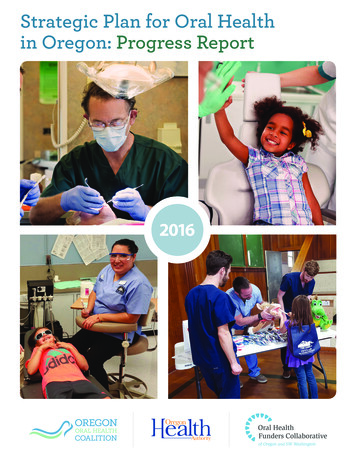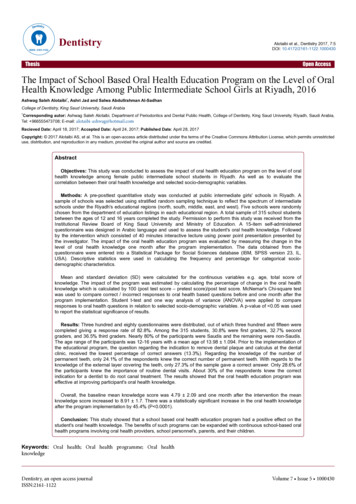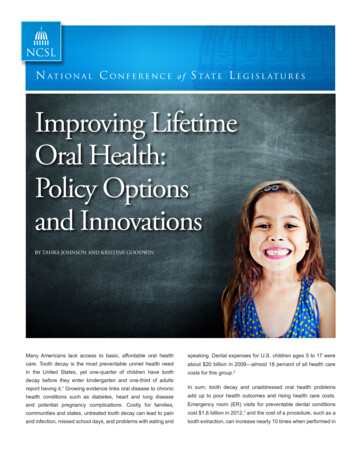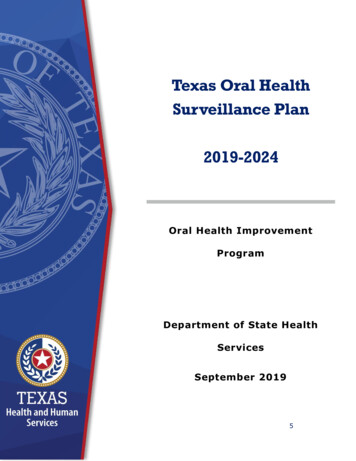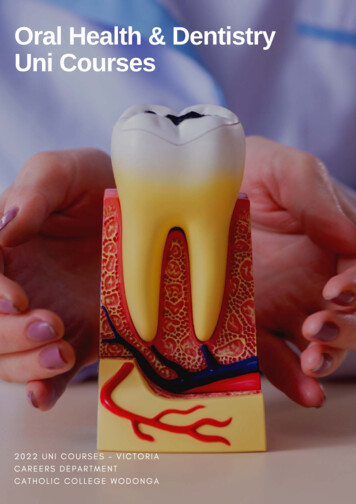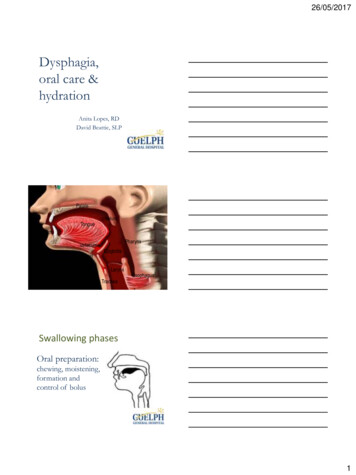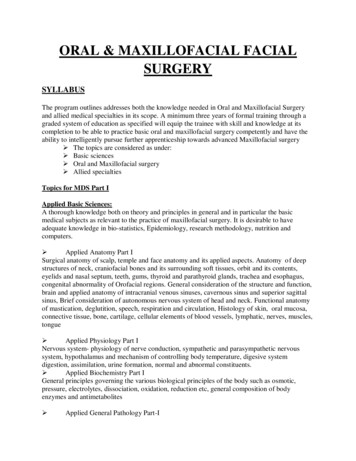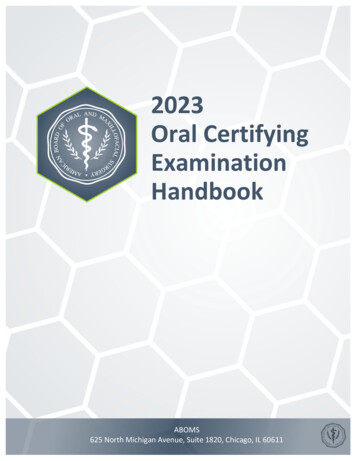
Transcription
ORAL HEALTH CARE SERIESWomen’s OralHealth IssuesNovember 2006American Dental AssociationCouncil on Access, Preventionand Interprofessional Relationssuccess.ada.org
FOREWORDWomen’s Oral Health Issues has been developed by the American Dental Association’s Council onAccess, Prevention and Interprofessional Relations (CAPIR)Women’s Oral Health Issues is one volume in the Oral Health Care Series that has been developedto assist in the treatment of individuals with complex medical conditions. The Oral Health CareSeries began in 1986 and was based on Clinical Care Guidelines for the Dental Management of theMedically Compromised Patient (1985, revised in 1990) developed by the Veterans HealthAdministration, Department of Veterans Affairs. Since that time, the Oral Health Care SeriesWorkgroup enhanced the documents to provide information on treating the oral health of patientswith complex medical conditions.DisclaimerPublications in the Oral Health Care Series, including Women’s Oral Health Issues, are offered asresource tools for dentists and physicians, as well as other members of the health care team. They arenot intended to set specific standards of care, or to provide legal or other professional advice.Dentists should always exercise their own professional judgment in any given situation, with anygiven patient, and consult with their professional advisors for such advice. The Oral Health CareSeries champions consultation with a patient’s physician as indicated, in accordance with applicablelaw.success.ada.org2
ACKNOWLEDGEMENTSThe Council acknowledges the pioneering efforts of the original Ad Hoc Committee of 1986:William Davis, DDS, MS; Ronald Dodson, DDS; Leon Eisenbud, DDS; Martin Greenberg, DDS;Felice O’Ryan, DDS, MS; David A. Whiston, DDS and Joseph W. Wilkes, III, DMD, MD. TheCouncil thanks past Committee members for their notable contributions: Walter F. Bisch, DDS; PeterS. Hurst, LDS, BDS, FDS, Malcolm Lynch, DDS, MD and Mark Tucker, DDS. Additionally, at thebeginning of this Series, there were numerous reviews by dental organizations and individualsincluding constituent dental societies, selected national dental organizations, deans of dental schools,chiefs of hospital dental departments and federal dental chiefs. The Council thanks all of theircolleagues who participated in the creation of the Series.The Council is grateful to Barbara Steinberg, DDS, who authored the initial draft of this document in1995.The Council is especially thankful to Linda Niessen, DMD, MPH, who generously gave of her timeto update this monograph. The Council also thanks Philip C. Fox, DDS, who authored the section onSalivary Dysfunction and Sjögren’s Syndrome and Lynn Mouden, DDS, MPH, who authored thesection on Violence.The Council wishes to express its deep appreciation to the Oral Health Care Series Workgroup,which worked so diligently and thoughtfully to make this document a reality. The Workgroup isstaffed by Sharon G. Muraoka, Manager, Interprofessional Relations, CAPIR. The Council thanksMs. Helen Ristic, Director, Scientific Information and Mr. Mark Rubin, Associate General Counsel,for their valuable contributions.Oral Health Care Series WorkgroupWilliam Carpenter, DDS, MSProfessor and ChairmanDepartment of Pathology and MedicineUniversity of the PacificSchool of DentistrySan Francisco, CAMichael Glick, DMDProfessor and ChairmanDepartment of Diagnostic SciencesNew Jersey Dental SchoolUniversity of Medicine and Dentistry of New JerseyNewark, NJsuccess.ada.org3
Steven R. Nelson, DDS, MSChair, Oral Health Care Series WorkgroupPrivate PracticeOral and Maxillofacial SurgeryDenver, COSteven M. Roser, DMD, MD, FACSProfessor and ChiefOral and Maxillofacial SurgeryEmory University School of MedicineAtlanta, GALauren L. Patton, DDSProfessorDepartment of Dental EcologySchool of DentistryUniversity of North Carolina at Chapel HillChapel Hill, NCsuccess.ada.org4
PreambleTopics for the volumes in the Oral Health Care Series have been carefully chosen. Situations existwhere modifications of dental treatment for the welfare of the patient are often necessary because ofthe patient’s medical condition or status or when acute adverse events associated with dental caremay be anticipated. Many diseases as well as some treatments are associated with oralmanifestations, which may reflect changes in the general health of the patient. The dentist isparticularly qualified and trained to diagnose and treat those oral conditions, improving the patient’soverall quality of life.It is beneficial to acquaint the physician with the positive contributions that timely and necessarydental treatment may make in decreasing morbidity and mortality from the patient’s disease. Anadvisory consultation between the dentist and the patient’s physician is often desirable to assess thepatient’s medical status. Medical information obtained from such a consultation should be consideredwhen developing the patient’s treatment options, as it is ultimately the responsibility of the dentist toensure safe and appropriate oral health care management.success.ada.org5
Table of ContentsI. BACKGROUND/RATIONALE.7II. ISSUES, MANIFESTATIONS AND DENTAL MANAGEMENT.8Puberty.8Menses.9Pregnancy.9Oral, Transdermal and Implanted Contraceptives .15Eating Disorders. .17Temporomandibular Disorders . 20Menopause.20Osteoporosis . .22Burning Mouth .25Salivary Dysfunction and Sjögren’s Disease. . . . .27Thyroid Disorders .29Violence Against Women .31III. TABLES.33IV. APPENDICES.39V. REFERENCES/RECOMMENDED READINGS.42success.ada.org6
I. BACKGROUND AND RATIONALEThe 2001 Institute of Medicine’s Report “Exploring the Biological Contributions to Human Health:Does Sex Matter?” focused international attention on gender-based biology and its implications forwomen’s health. This report states that by understanding the roles of sex and gender in biology,scientists can better understand these effects on disease and its prevention and treatment.The U.S. Public Health Service’s Task Force on Women’s Health defined women’s health asdiseases or conditions that are unique to, more prevalent in or more serious in women; have distinctcauses or manifest themselves differently in women; or have different outcomes or require differentinterventions than men. This definition encompasses oral diseases and conditions.Women have special oral health needs and considerations. Hormonal fluctuations have a surprisinglystrong influence on the oral cavity. Puberty, menses, pregnancy, menopause and use of contraceptivemedications all influence women’s oral health and the way in which a dentist should approachtreatment.This document will discuss hormonal effects on the oral cavity during various stages in women’slives as well as the special dental needs and considerations that will be encountered. Problems suchas osteoporosis, Sjögren’s disease, temporomandibular disorders, eating disorders and thyroiddisease, prevalent in the female population, will also be addressed.Dentists should always exercise their own professional judgment in any given situation, with anygiven patient. This publication does not set any standards of care. Scientific advances, unique clinicalcircumstances, and individual patient preferences must be factored into clinical decisions. Thisrequires the dentist’s careful judgment. Balancing individual patient needs with scientific soundnessis a necessary step in providing oral health care. 2success.ada.org7
II. ISSUES, MANIFESTATIONS AND DENTAL MANAGEMENTPUBERTYINCIDENCE AND PREVALENCEAt puberty, girls have an increase in the production of their sex hormones (estrogen andprogesterone) that remains relatively constant throughout their reproductive lives. Data suggest thatgirls are experiencing puberty at younger ages than previous cohorts. The reason for this earlieroccurrence of puberty is not clear.ORAL MANIFESTATIONSA number of studies have shown that increased sex hormone levels correlate with an increasedprevalence of gingivitis. Gingival tissues and the subgingival microflora respond with a variety ofchanges to the increasing hormone level at the onset of puberty. Microbial changes have beenreported during puberty and can be attributed to changes in the microenvironment seen in thegingival tissue response to the sex hormones as well as the ability of some species of bacteria tocapitalize on the higher concentration of hormones present. In particular, some gram-negativeanaerobes such as Prevotella intermedia have the ability to substitute estrogen and progesterone forvitamin K, an essential growth factor. Another gram-negative bacterium, Capnocytophagia species,increases in incidence as well as in proportion. These organisms have been implicated in theincreased gingival bleeding observed during puberty.Clinically during puberty there may be a nodular overgrowth reaction of the gingiva in areas wherefood debris, materia alba, plaque and calculus are deposited. The inflamed tissues are deep red andmay be lobulated, with ballooning distortion of the interdental papillae. Bleeding may occur whenpatients masticate or brush their teeth. Histologically, the appearance is consistent with inflammatoryfibroplasia.DENTAL MANAGEMENTLocal preventive care, including a vigorous program of good oral hygiene is vital. Mild cases ofgingivitis respond well to scaling and improved oral hygiene. Severe cases of gingivitis may requiremore aggressive treatment, including antimicrobial therapy. If the patient’s gingivitis does notrespond, more frequent recall during puberty may be indicated.Appendix 1 lists key questions for the dentist to consider asking the female patient in various stagesof their life, as well as their physician. 3success.ada.org8
MENSESINCIDENCE AND PREVALENCEWomen in their reproductive years should experience menses on a regular cycle. Changes orvariation in the menstrual cycle or flow should be addressed by the woman and her physician.ORAL MANIFESTATIONSOral changes that may accompany the menses include swollen erythematous gingiva. Some femalesare not aware of any gingival changes at all, while others complain of bleeding and swollen gingivain the days preceding the onset of menstrual flow, which usually resolves once menses begins. Otheroral changes include activation of recurrent herpes infection; aphthous ulcers; prolonged hemorrhagefollowing oral surgery; and swollen salivary glands, particularly the parotid glands.DENTAL MANAGEMENTLocal preventive care, including a vigorous program of good oral hygiene is vital. Topical and/orsystemic antiherpetic medication may be beneficial for patients experiencing recurrent herpeticoutbreaks. Topical corticosteroids may also be indicated for severe aphthous ulcers. Palliativetreatment, such as topical anesthetic agents and/or systemic analgesics, may be necessary for thediscomfort associated with the aphthous ulcerations and herpetic lesions.PREGNANCYINCIDENCE AND PREVALENCEThe CDC’s National Center for Health Statistics reported there were 6.4 million U.S. pregnancies in2000. The 2000 total pregnancy count includes about 4 million live births, 1.3 million inducedabortions and 1 million fetal losses (miscarriages and stillbirths). Approximately 10 percent of allwomen in the age group 15-44 are pregnant. In addition, with advancing medical technology andmore women delaying childbearing, there is an increased incidence of women undergoing fertilitytreatments.ORAL MANIFESTATIONSThe notion that pregnancy causes tooth loss (“a tooth lost for every child”) and that calcium iswithdrawn in significant amounts from the maternal dentition to supply fetal requirements has nohistologic, chemical or radiographic evidence to support it. Calcium is present in the teeth in a stablecrystalline form and, as such, is not available to the 4success.ada.org9
systemic circulation to supply a calcium demand. However, calcium is readily mobilized from boneto supply these demands.CariesThe relationship between dental caries and pregnancy is not well defined. The more comprehensiveclinical studies suggest that pregnancy does not contribute directly to the carious process. It is mostprobable that when an increase in caries activity is noted, it can be attributed to an increase in localcariogenic factors. Pregnancy causes an increase in appetite and often a craving for unusual foods. Ifthese cravings are for cariogenic foods, the pregnant woman could increase her caries risk at thistime.Acid erosion of teeth (perimylolysis)Acid erosion rarely occurs as the result of repeated vomiting associated with morning sickness oresophageal reflux. Women can be instructed to rinse the mouth with water immediately aftervomiting so that stomach acids will not remain in the mouth.Gingival inflammationGingivitis is the most prevalent oral manifestation associated with pregnancy. It has been reported tooccur in 60 to 75 percent of all pregnant women. Gingival changes usually occur in association withpoor oral hygiene and local irritants, especially plaque. However, the hormonal and vascular changesthat accompany pregnancy often exaggerate the inflammatory response to these local irritants.Clinically, the appearance of inflamed gingiva during pregnancy is characterized by a fiery red colorof the marginal gingiva and interdental papillae. The tissue is edematous, with a smooth, shinysurface, loss of resiliency and a tendency to bleed easily. There may also be increased pocket depthwith minimal loss of attachment apparatus (pseudopocket). Gingival changes are most noticeablefrom the second month of gestation, reaching a maximum in the eighth month. These changes occurearlier and more frequently anteriorly than in posterior areas. The severity of gingival disease isreduced after childbirth, but the gingiva does not necessarily return to its pre-pregnancy condition.In addition to generalized gingival changes, pregnancy may also cause single, tumor-like growths,usually on the interdental papillae or other areas of frequent irritation. This localized area of gingivalenlargement is referred to as a pregnancy tumor, epulis gravidarum or pregnancy granuloma. Thehistologic appearance is a pyogenic granuloma. It may occur in up to 10 percent of pregnant women.The lesion occurs most frequently on the labial aspect of the maxillary anterior region during thesecond trimester. It often grows rapidly, although it seldom becomes larger than 2 cm in diameter.A pregnancy tumor classically starts to develop in an area of an inflammatory process. Poor oralhygiene is invariably present, and often there are deposits of plaque or calculus 5success.ada.org10
on the teeth adjacent to the lesion. The gingiva enlarges in a nodular fashion to give rise to theclinical mass. The fully developed pregnancy tumor is a sessile or pedunculated lesion that is usuallypainless. The color varies from purplish red to deep blue, depending on the vascularity of the lesionand the degree of venous stasis. The surface of the lesion may be ulcerated and covered by yellowishexudate, and gentle manipulation of the mass easily induces hemorrhage. Bone destruction is rarelyobserved around pregnancy tumors.Generally, the lesion will regress postpartum; however, surgical excision is often required forcomplete resolution. Before parturition, scaling and root planing, as well as intensive oral hygieneinstruction, may need to be initiated to reduce the plaque retention.In cases when it is uncomfortable for the patient, disturbs the alignment of the teeth or bleeds easilyon mastication, the patient may seek treatment. When the pregnancy tumor interferes with function, itneeds to be excised. Pregnancy tumors excised before term may recur; therefore, the patient shouldbe advised that revision of the surgical procedure may have to be performed postpartum.Tooth mobilityGeneralized tooth mobility may also occur in the pregnant patient. This change is probably related tothe degree of periodontal disease disturbing the attachment apparatus. This condition usually reversesafter delivery.XerostomiaSome pregnant women complain of dryness of the mouth. Hormonal alterations associated withpregnancy are a possible explanation. More frequent consumption of water and sugarless candy andgum may help alleviate this problem.Ptyalism/SialorrheaA relatively rare finding among pregnant women is excessive secretion of saliva, known as ptyalismor sialorrhea. It usually begins at two to three weeks of gestation and may abate at the end of the firsttrimester. In some instances, it continues until the day of delivery.Periodontal Disease and Preterm Low Birth Weight InfantsIn the United States, about 10 percent of all births are low birth weight infants. The March of Dimeshas reported that 25 percent of women who deliver a low birth weight infant have no known riskfactors. Maternal risk factors for preterm low birth weight (PLBW) include: age, low socioeconomicstatus, alcohol and tobacco use, diabetes, obesity, hypertension and genitourinary tract infections.PLBW results in significant morbidity and mortality of infants.Research over the past several years has demonstrated an association between maternal infection andPLBW. Additional research suggests that periodontal disease may 6success.ada.org11
represent a previously unrecognized risk factor for PLBW. Oral health care for the pregnant womanshould include an assessment of her periodontal status and if diagnosed, at a minimum shouldinclude prophylaxis or scaling and root planing to decrease the infection and subsequentinflammation caused by the disease.DENTAL MANAGEMENTThe evaluation of the pregnant patient begins with a thorough history. Indications of high-riskpregnancy such as previous miscarriages, recent cramping or spotting warrant consultation with theobstetrician prior to initiating dental treatment.The most important objectives in planning dental treatment for the pregnant patient are to establish ahealthy oral environment and to obtain optimum oral hygiene levels. These are achieved by means ofa good preventive dental program consisting of nutritional counseling and rigorous plaque controlmeasures in the dental office and at home.Women undergoing fertility treatment do not require any modification of dental treatment. However,consultation with the treating physician is advisable.Preventive ProgramNutrition – The quality of the diet affects caries formation and pregnancy gingivitis. Diet is alsoimportant for the developing dentition in the fetus. Pregnant patients normally receive nutritionalguidance from their obstetricians, which may be reinforced by the dental team. It is imperative thatthe mother’s diet supply sufficient levels of needed nutrients, including vitamins A, C and D; protein;calcium; folic acid; and phosphorus. Patients should select nutritious snacks, but because so manyfoods contain sugars and starches that can contribute to caries development, it is advisable to limitthe number of times they snack between meals.Plaque control – Pregnant patients should maintain a good plaque control program to minimize theexaggerated inflammatory response of the gingival tissues. The heightened tendency for gingivalinflammation may be clearly explained to the patient so that acceptable oral hygiene techniques maybe taught, reinforced and monitored throughout pregnancy. Scaling, polishing and root planing maybe performed whenever necessary throughout the pregnancy. If periodontal disease is diagnosed,scaling and root planing should be implemented to decrease the inflammation caused by theperiodontal infection.Prenatal fluoride – The American Academy of Pediatrics has adopted the Centers for DiseaseControl and Prevention (CDC) Recommendations for using fluoride to prevent and control caries inthe United States which states “the use of fluoride supplements by pregnant women does not benefittheir offspring.” The American Academy of Pediatric Dentistry has stated, “the efficacy of prenatalfluoride is still equivocal, although its use in fluoride-deficient communities (less than 0.3 ppm F) isconsidered to be safe for both the mother and the fetus.” 7success.ada.org12
Elective dental treatment – Elective dental care should be timed to occur during the secondtrimester and first half of the third trimester. The first trimester is the period of organogenesis whenthe fetus is highly susceptible to environmental influences. In the last half of the third trimester, thewoman may be less comfortable sitting in the dental chair and there is a possibility that supinehypotensive syndrome may occur. In a semi-reclining or supine position, the great vessels,particularly the inferior vena cava, are compressed by the gravid uterus. By interfering with venousreturn, this compression will cause maternal hypotension, decreased cardiac output and eventual lossof consciousness. Supine hypotensive syndrome can usually be reversed by turning the patient on herleft side, thereby removing pressure on the vena cava and allowing blood to return from the lowerextremities and pelvic area. Women who experience this will often report that they sleep partiallysitting up or on their side. Extensive reconstruction procedures and major surgery should bepostponed until after delivery.Emergency dental treatment – Dental emergencies should be dealt with as they arise throughoutthe entire pregnancy. The management of pain and elimination of infection that otherwise couldresult in increased stress for the mother and endangerment of the fetus are hallmarks of emergentdental care. Emergency treatment calling for sedation/general anesthesia necessitates consultationwith the patient’s obstetrician, as does any uncertainty about prescribing medication or pursuing aparticular course of treatment.Dental radiographs – Dental radiographs may be needed for dental treatment or a dental emergencythat cannot be delayed until after the baby is born. Untreated dental infections can pose a risk to thefetus, and dental treatment may be necessary to maintain the health of the mother and child.Radiation exposure from dental radiographs is extremely low. However, every precaution should betaken to minimize any exposure by use of high-speed film, filtration, collimation, and protectiveabdominal and thyroid shielding. Abdominal shielding minimizes exposure to the abdomen andshould be used when any dental radiograph is taken. Studies have shown that when a leaded apron isused during dental radiography, gonadal and fetal radiation is negligible. A protective thyroid collarcan protect the thyroid from radiation, and should be used whenever possible. The use of a thyroidcollar is strongly recommended for women of childbearing age, pregnant women and children.Dental radiographs are not contraindicated if one is trying to become pregnant or is breast feeding.When possible, x-rays should be delayed until after the pregnancy.Medications – Drugs given to a pregnant woman can affect the fetus. In 1979, the FDA established aclassification system to rate fetal risk levels associated with many prescription drugs (Table 1).Additionally, references such as ADA Guide to Dental Therapeutics, Briggs Drugs in Pregnancy andLactation or Drug Facts and Comparisons or Drug Information Handbook for Dentistry are availablefor information on the prescription drugs associated with pregnancy risk factors. 8success.ada.org13
Most of the commonly used drugs in dental practice can be given during pregnancy with relativesafety, although there are a few important exceptions. The table of drugs presented in Table 2 isconsidered to be a general guideline. Obviously, drugs in category A or B are preferable forprescribing. However, many drugs that fall into category C are sometimes administered duringpregnancy. These drugs will present the greatest challenge for the dentist and physician in terms oftherapeutic and medicolegal decisions. Consulting the patient’s physician may be advisable prior toprescribing any medications during pregnancy.Breastfeeding – During breastfeeding, there is a risk that the drug can enter the breast milk and betransferred to the nursing infant, in whom exposure could have adverse effects. There is littleconclusive information about drug dosage and effects via breast milk. Retrospective clinical studiesand empirical observations coupled with known pharmacologic pathways allow recommendations tobe made. The amount of drug excreted in breast milk is usually not more than 1 to 2 percent of thematernal dose; however for some drugs used in dentistry, such as metronidazole, the amount excretedcan be up to one-third of the maternal dose.Table 2 also lists recommendations regarding administration of commonly used dental drugs duringbreastfeeding. These recommendations are general guidelines only; as with drug use in pregnancy,individual physicians may wish to modify these suggestions.In addition to choosing drugs carefully, it is desirable for the mother to take the drug just afterbreastfeeding and then to avoid nursing for four hours or more if possible. If there is serious concernabout the drug passing to the child through the breast milk, particularly narcotics or anti-anxietyagents, the mother may elect to pump the breast milk and discard it after taking the medication. Thiswill markedly decrease the drug concentration in breast milk that is consumed by the child.Early Childhood Caries (ECC), formerly known as Baby Bottle Tooth Decay (BBTD) – Whendiscussing preventive oral health with the patient, it is advisable to mention the condition known asEarly Childhood Caries (formerly known as Baby Bottle Tooth Decay or BBTD) for the benefit ofthe mother and other caregivers. ECC is an easily preventable condition affecting primary teeth.Early signs of ECC are white demineralized lines at the cervical areas of the maxillary anteriordeciduous teeth. It is caused by frequent and prolonged exposure of the primary teeth to fluidscontaining sugars such as breast milk, milk, formula, fruit juice and other sweetened liquids providedduring feeding. It can occur when a mother breastfeeds her child at will during the night, or puts thechild to bed with a bottle holding a sugar containing liquid at night. Children who carry “sippy cups”all day with liquids containing sugar are also at risk of ECC. Caring for the pregnant woman providesan opportunity to counsel her about the prevention of ECC by avoiding certain feeding practices. 9success.ada.org14
ORAL, TRANSDERMAL AND IMPLANTED CONTRACEPTIVESINCIDENCE AND PREVALENCEThe number of women taking oral contraceptives has reached an estimated 8 million to 10 million inthe United States and 50 million worldwide. As a result of such widespread use, many systemic andoral side effects have been identified.ORAL MANIFESTATIONSOral contraceptives can exacerbate patients’ inflammatory status, causing erythema and an increasedtendency toward gingival bleeding. In some instances, oral contraceptives have been reported toinduce gingival enlargement.All studies recording changes in gingival tissues associated with oral contraceptives were completedwhen contraceptive concentrations were at much higher levels than are available today. A recentclinical study evaluating the effects of oral contraceptives on gingival inflammation in young womenfound these hormonal agents to have no effect on gingival tissues. From these data, it appears thatcurrent compositions of oral contraceptives probably are not as harmful to the periodontium as werethe early formulations. Nonetheless, a controlled oral hygiene program that includes regular oralexaminations, professional cleanings and plaque control will minimize the effects of oralcontraceptives. These drugs also may increase the incidence of local alveolar osteitis after extractionof teeth.Reports have shown significant increased risk for developing myocardial infarction and strokes inwomen who concomitantly smoke and take oral contraceptives. This may be a more important issueamong women older than 30 years.SalivaMeasurable changes have been observed in the salivary components and flow in women takingcontraceptive medications. These changes include a decrease in concentrations of protein, sialic acid,hydrogen ions and total electrolytes. Studies have shown both an increase and decrease in salivaryflow.Localized osteitis (“dry socket”)It has been reported that women taking contraceptive medications may experience a higher incidenceof localized osteitis following extraction of teeth. However, no additional preventive procedures arerecommended at the time of extractions and treatment for patients developing localized osteitis isaccording to the clinician’s dry socket protocol. 10success.ada.org15
Interaction between oral contraceptives and antibioticsAntibiotic interference with contraceptive medication levels is controversial. Although results fromanimal studies support antibiotic interference with contraceptive levels, studies in humans
Women's Oral Health Issues is one volume in the Oral Health Care Series that has been developed to assist in the treatment of individuals with complex medical conditions. The Oral Health Care Series began in 1986 and was based on Clinical Care Guidelines for the Dental Management of the Medically Compromised Patient (1985, revised in 1990) developed by the Veterans Health
